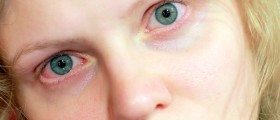
The most common bacterial infection of the eye are conjunctivitis, blepharitis and keratitis. Conjunctivitis is an infection of the conjunctiva, which includes the outmost layer of the eye and the inside parts of the eyelids. Blepharitis involves eyelids and keratitis is the infection of the cornea.
Bacterial eye infections are treated with antibiotics, although there are those that are self-limiting and go away without any treatment.
Bacterial conjunctivitis
Conjunctivitis is an inflammation of the conjunctiva, which may be allergic, chemical or infectious. Infectious conjunctivitis is usually either viral or bacterial. Bacterial conjunctivitis may be caused by any of the common pus-producing bacteria and it is characterized by irritation, itching, pain, redness and swelling, as well as by stringy, sticky and yellowish discharge. The discharge may cause the eyelids to stick together, making it hard to open the eyes, especially in the morning. Bacterial conjunctivitis is also characterized by crusting. However, there are types of bacteria that do not cause the discharge or pus, such as Chlamydia trachomatis or Moraxella, meaning that pus is not essential for the diagnosis.
Bacterial blepharitis
Blepharitis is an infection of the eyelids that usually has a bacterial cause. The two main types are anterior and exterior blepharitis. Anterior blepharitis affects the front part of the eyelids, where the eyelashes are located, while interior type of this infection involves meibomian glands, located within the eyelids, which secrete lubrication oils necessary for normal functioning of the eye.
Bacterial blepharitis, usually caused by streptococcal bacteria, is more severe than other forms of this infection and may even lead to the loss of eyelashes. This infection needs to be treated appropriately, otherwise it may cause complications such as thickened eyelids, permanently dilated blood vessels, ectropion, entropion and trichiasis. Some of these complications may subsequently cause corneal damage.
Bacterial keratitis
Bacterial or microbial keratitis is an infection involving the cornea, which is the front part of the eye. This infection is one of the common problems associated with contact lenses, because contacts, solutions and unclean hands may serve as a route for many microorganisms. Pseudomonas aeruginosa is a type of bacteria that is commonly associated with contact lenses, and, unfortunately, one of the most damaging. This bacterium eats away the cornea, causing ulcerations. If it is left untreated, it can lead to permanent corneal damage, vision problems and even blindness.
Other bacteria that commonly cause keratitis are Serratia and Staphylococcus.
The common symptoms of bacterial keratitis include pain, which ranges from moderate to severe, and vision problems, such as clouded or blurry vision.

















Your thoughts on this
Loading...